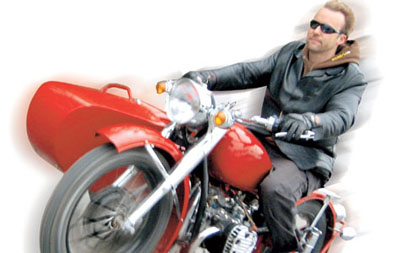Vintage cycle
Updated: 2006-08-01 10:35
|
|
There's a wonderful correctness, a sort of poetic confluence, about the resurrection of the vintage Chang Jiang 750 motorcycle with sidecar.
With Shanghai's star firmly in the ascendancy, the roar of this design classic can be heard more and more on the city's streets. It somehow taps a number of peculiarly Shanghainese predilections. There's the nostalgic element, these motorbikes were first built way back in 1938; there's the practical, purposeful nature of the beast - easy to maintain, easy to ride, reliable and robust. Also, as a fully fledged design classic alongside the likes of the Volkswagen Beetle, the Swiss Army knife and Levi 501 jeans, these motorbikes are never out of fashion.
There's even a filmic touch with this bike appearing in dozens of films, perhaps most notably "The Great Escape" and more recently the Shanghai-set "The White Countess."
Jeff Marquass of Marquass Motorcycles says: "These bikes are perfect for cruising around on. They're practical and sociable and, most importantly, they're a lot of fun. Riding around on one, you feel like a rock star."
The original bike, the BMW R71, upon which the Chang Jiang is based, was designed and first built in pre-World War II Germany. After the war, the Russians dismantled most of BMW's production equipment and tooling, and shipped it all back to the Ural Mountains. There, JMZ company in Irbit began producing the motorbike they called the M72.
A second production line was set up by KMZ company in Kiev, Ukraine, to produce the Dnepr motorbike. The Russians shared this technology with their Chinese allies, and the China Nanchang Aircraft Manufacturing Company started production of the Chang Jiang motorbike with sidecar.
Both the Russian and Chinese machines may look similar, but that similarity is only skin deep. The Chang Jiang has more similarities with modern BMW motorbikes. It has a three-phase 12-volt alternator fitted on the front of the engine where the distributor and coil were previously. The distributor was moved to the left side of the crankcase, again simplifying the design and making maintenance easier. The coil was also moved to the right side of the crankcase, making the design and overall maintenance simple.
|
||
|
||
| Eating out:
Arriba arrives in the Wu
Bars&Cafes: Mare's milk a-go-go Weekend&Holiday: Ancient sites re-open after renovation Shopping: Jimmy Choo comes What's on: New shows on stage |
|
||
| Eating out:
Moroccan roll
Bars&Cafes: A boonna in training Weekend&Holiday: Pop power Shopping: LV boutique in E. China closed for disqualification What's on: Jazz-infused journey through Kunqu Opera |




